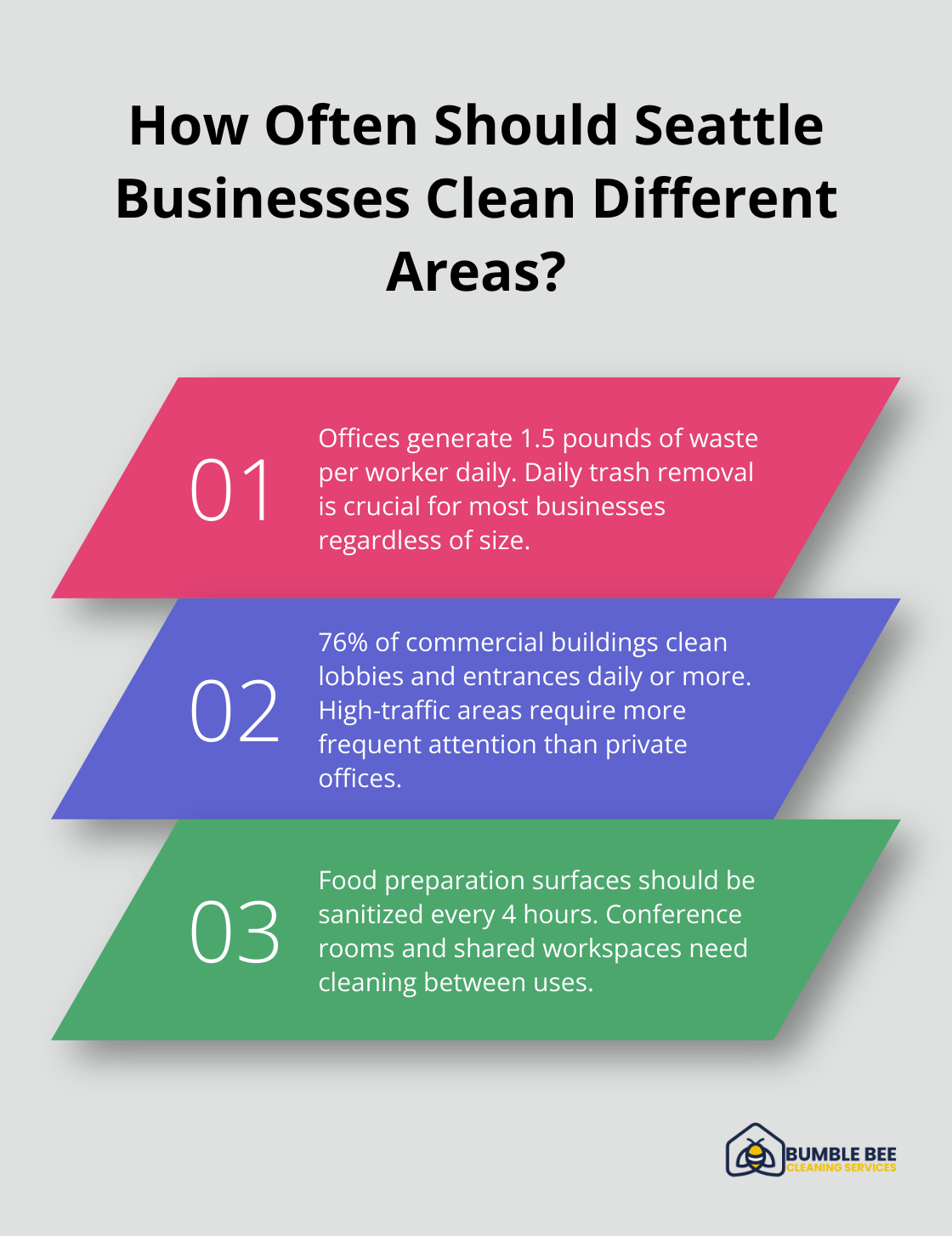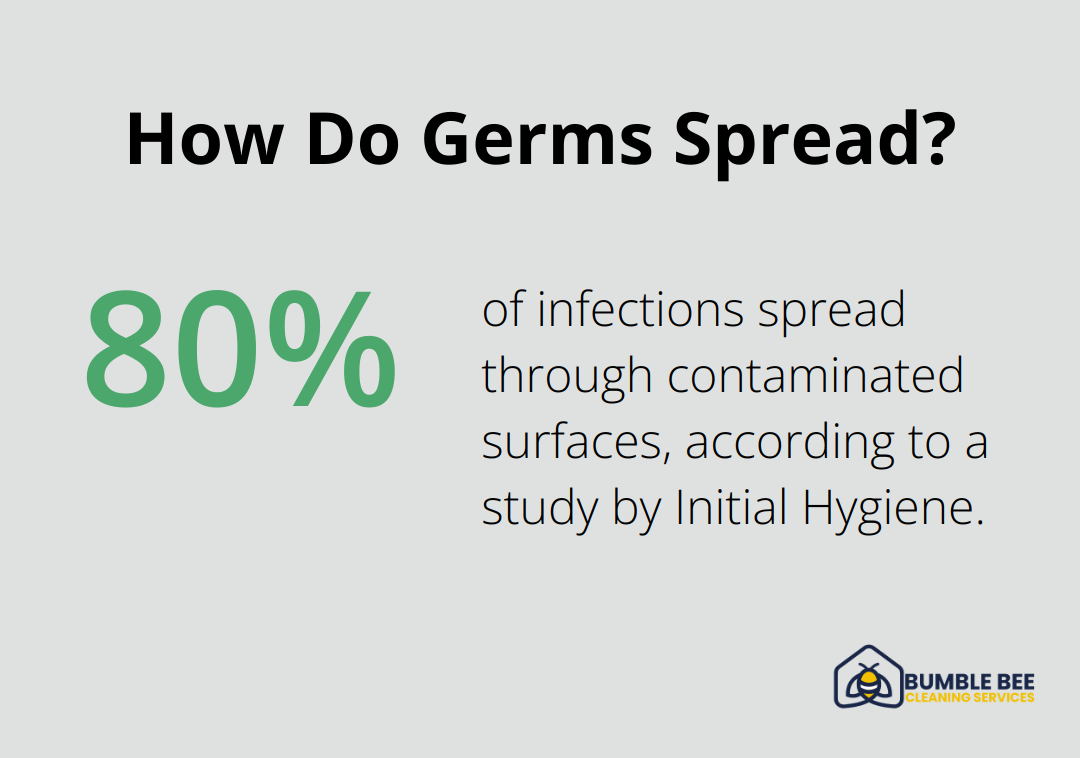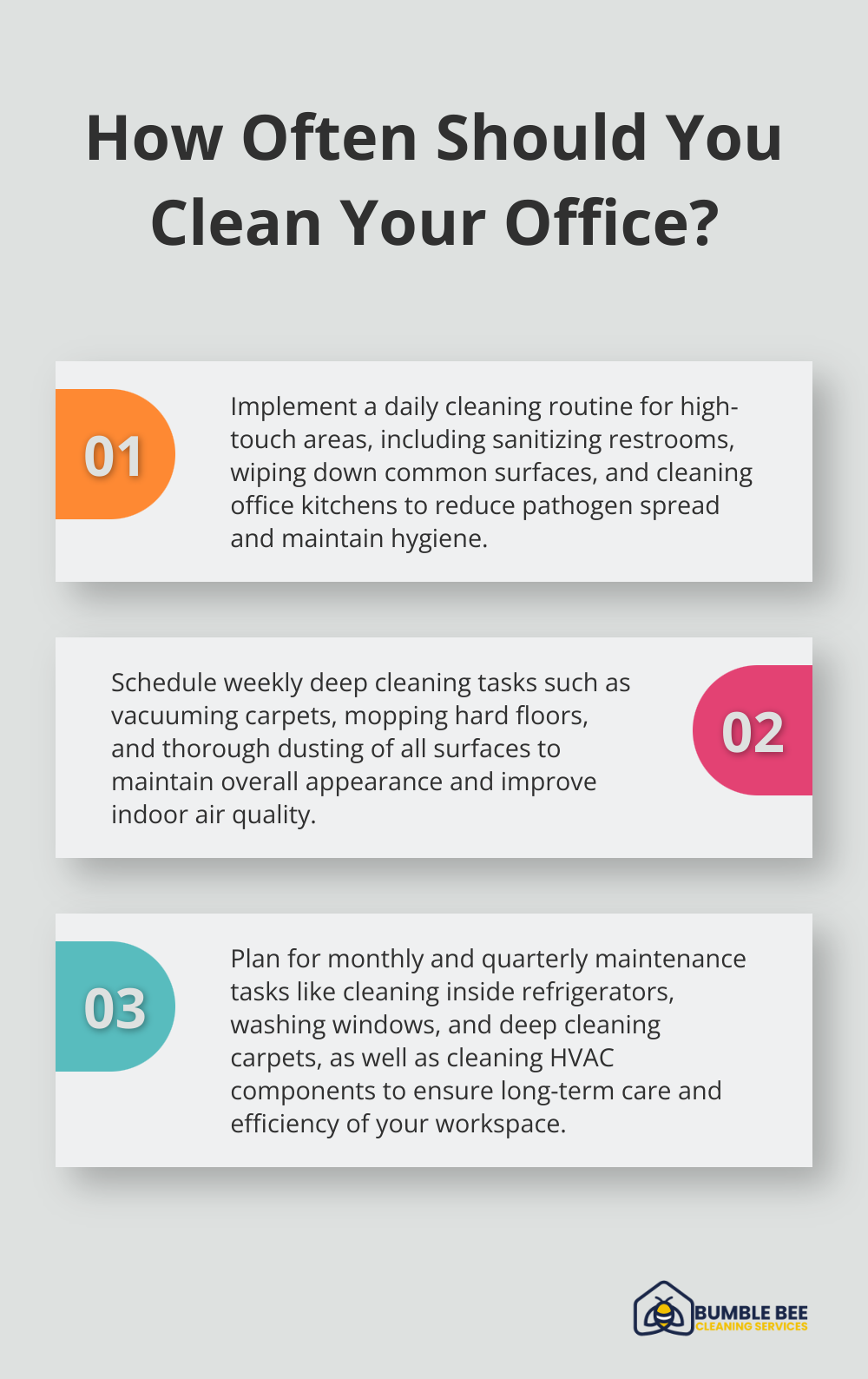A well-structured janitorial cleaning schedule is the backbone of a pristine and professional business environment. At Bumble Bee Cleaning Services, we’ve seen firsthand how a tailored cleaning plan can transform workspaces in Seattle.
This blog post will guide you through creating an effective janitorial cleaning schedule that meets your business’s unique needs. We’ll explore key factors to consider, essential tasks to include, and how to optimize your cleaning routine for maximum impact.
Why A Janitorial Cleaning Schedule Is Essential
Enhancing Employee Productivity and Satisfaction
A clean workspace revolutionizes productivity. Research by Staples found that 94% of employees reported feeling more productive in a clean environment. This productivity boost can lead to substantial gains for your business over time.

Clean workplaces also contribute to employee satisfaction. The National Cleaning Institute found that 31% of households struggle with regular cleaning tasks, which leads to increased stress and decreased productivity. This statistic underscores the importance of maintaining a clean work environment for employee well-being and efficiency.
Elevating Your Professional Image
First impressions matter in business. A clean, well-maintained office or commercial space sends a powerful message about your company’s professionalism and attention to detail.
The International Sanitary Supply Association (ISSA) found that 95% of shoppers report that cleanliness can influence their perception of a business. This statistic (while focused on retail) underscores the importance of cleanliness in shaping public perception across all industries.
Optimizing Budget and Resource Allocation
A structured cleaning schedule serves as a financial tool. Advanced planning of cleaning tasks allows better resource allocation, cost prediction, and avoidance of unexpected expenses.
Regular maintenance of carpets and upholstery can extend their lifespan by up to 50% (according to the Carpet and Rug Institute). This proactive approach leads to significant savings over time, reducing the frequency of costly replacements.
Tailoring Your Schedule for Maximum Impact
Every business has unique needs, and your cleaning schedule should reflect that. Consider factors like foot traffic, type of business, and specific area requirements when crafting your schedule. A high-traffic lobby might need daily attention, while private offices could require less frequent cleaning.
A cleaning schedule isn’t static. It should evolve with your business needs. Regular reviews and adjustments ensure that your cleaning efforts remain effective and efficient, providing the best possible return on your investment in cleanliness.
As we move forward, we’ll explore the key factors to consider when creating your janitorial cleaning schedule, ensuring it meets the specific needs of your Seattle business.
How to Tailor Your Cleaning Schedule for Seattle Businesses
Assess Your Business Type and Size
The nature and scale of your business significantly influence your cleaning needs. A small boutique shop might require daily dusting and weekly floor cleaning, while a large office complex could need nightly vacuuming and daily restroom sanitization.

The International Facility Management Association reports that office workers generate an average of 1.5 pounds of waste per day. This statistic underscores the importance of daily trash removal for most businesses, regardless of size.
Analyze Foot Traffic Patterns
High-traffic areas demand more frequent attention. In a typical office, reception areas and main corridors might need cleaning multiple times a day, while private offices could be cleaned less frequently.
A survey by the Building Owners and Managers Association found that lobbies and entrances are the most frequently cleaned areas in commercial buildings (with 76% of respondents cleaning these spaces daily or multiple times per day).
Address Specific Area Requirements
Different areas within your business have unique cleaning needs. For instance, kitchens and break rooms require daily sanitization to maintain hygiene standards. The National Restaurant Association recommends sanitizing food preparation surfaces at least every four hours to prevent bacterial growth.
Conference rooms might need attention only after use, focusing on table surfaces and technology equipment. The Occupational Safety and Health Administration (OSHA) suggests cleaning and disinfecting shared workspaces between uses.
Account for Seattle’s Seasonal Changes
Office cleaning Seattle is important due to the unique challenges presented by the city’s climate. During the rainy season (October to March), increased mud and moisture tracked into buildings necessitate more frequent entryway cleaning and floor maintenance.
According to the Consumer Product Safety Commission, floors and flooring materials contribute directly to more than 2 million fall injuries each year. This statistic highlights the importance of adapting your cleaning schedule to weather conditions, particularly in a city known for its rainfall.
Summer months might require increased attention to air conditioning vents and windows to combat dust and pollen. The Asthma and Allergy Foundation of America ranks Seattle as one of the top 100 most challenging places to live with allergies, emphasizing the need for thorough cleaning during peak allergy seasons.
Implement a Flexible Schedule
A well-tailored cleaning schedule should remain flexible to accommodate unexpected events or changes in your business operations. Try to build in some buffer time for unforeseen cleaning needs, such as spills or last-minute client visits.
Regular reviews of your cleaning schedule (perhaps quarterly) will help ensure it continues to meet your business’s evolving needs. This proactive approach allows you to adjust your cleaning routine before small issues become major problems.
As we move forward, we’ll explore the essential elements that should form the backbone of your janitorial cleaning schedule, ensuring comprehensive coverage of all your business’s cleaning needs.
Essential Tasks for Your Janitorial Cleaning Schedule
Daily Maintenance for a Spotless Workspace
Your cleaning routine should address high-touch areas and spaces with constant use every day. This includes emptying trash bins, sanitizing restrooms, and wiping down common surfaces. The Centers for Disease Control and Prevention (CDC) emphasizes the importance of cleaning high-touch surfaces at least once a day or as often as necessary to reduce pathogen spread.

Restroom cleaning is non-negotiable on a daily basis. A study by Initial Hygiene found that 80% of infections spread through contaminated surfaces, highlighting the need for thorough daily sanitization of these areas.
Office kitchens and break rooms require daily cleaning of countertops, sinks, and appliances. The National Sanitation Foundation reports that food preparation areas can harbor more bacteria than other office spaces, making daily attention to these areas vital.
Weekly Deep Cleaning for Lasting Freshness
Weekly tasks focus on more thorough cleaning to maintain the overall appearance and hygiene of your space. This includes vacuuming carpets, mopping hard floors, and dusting all surfaces (including window sills, baseboards, and light fixtures).
The Carpet and Rug Institute recommends vacuuming high-traffic areas daily and medium-traffic areas twice a week to maintain carpet appearance and extend its lifespan. For hard floors, weekly mopping prevents dirt and grime buildup that can damage surfaces over time.
Dusting is another critical weekly task. The American Lung Association notes that regular dusting can significantly improve indoor air quality, reducing allergens and irritants that can affect employee health and productivity.
Monthly and Quarterly Maintenance for Long-Term Care
Monthly and quarterly tasks involve more intensive cleaning that addresses less frequently used areas or those requiring specialized attention. This might include cleaning inside refrigerators, washing windows, and deep cleaning carpets.
The Environmental Protection Agency (EPA) recommends cleaning HVAC system components (including drain pans and cooling coils) on a quarterly basis to maintain indoor air quality and system efficiency.
For carpet maintenance, manufacturers’ recommendations for cleaning provide adequate guidelines, calling for frequent vacuuming and periodic professional deep cleaning.
Annual Deep Cleaning for a Fresh Start
Annual tasks are those big cleaning projects that keep your facility in top shape year after year. This might include stripping and waxing floors, cleaning light fixtures, and pressure washing exterior surfaces.
The National Air Duct Cleaners Association (NADCA) recommends cleaning air ducts every 3 to 5 years to maintain optimal indoor air quality and HVAC system efficiency. However, businesses in areas with high pollution or those with sensitive occupants might benefit from more frequent cleanings.
Final Thoughts
A well-crafted janitorial cleaning schedule forms the foundation of a pristine, healthy, and productive business environment. Your cleaning routine must adapt to your specific needs to maintain consistently high standards of cleanliness. This approach will impress clients, boost employee morale, and protect your investment in your physical space.

We recommend you review and adjust your cleaning schedule regularly to meet your evolving business needs. As your business grows, your cleaning requirements may change. You should reassess your janitorial cleaning schedule quarterly, or when you notice significant changes in workspace usage or employee feedback.
At Bumble Bee Cleaning Services, we understand the unique cleaning challenges Seattle businesses face. Our team can help you develop and implement a customized janitorial cleaning schedule that addresses your specific needs. Contact Bumble Bee Cleaning Services to create and maintain a clean, healthy, and inviting business environment (with our commitment to exceptional service).
